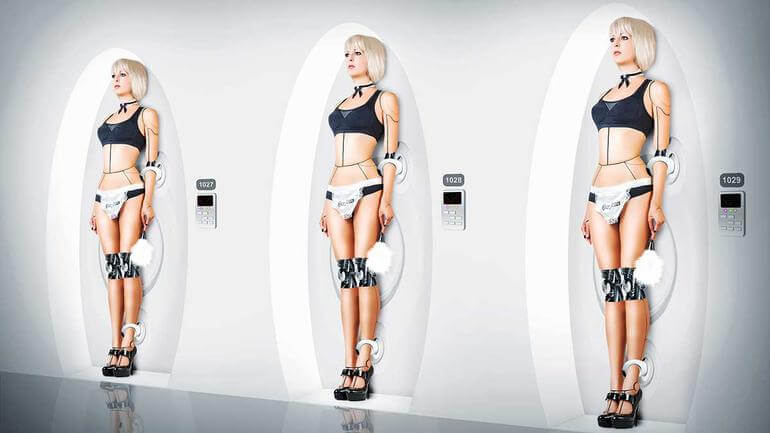Long-distance kisses, hugs, and caresses. Virtual reality porn stars. Sex robots threatening the world’s oldest profession. Technosexuals living with life-sized dolls. At the dawn of a new sexual revolution, it’s time to face where technology may take the most intimate area of our lives.
If technology is everywhere, why would sex be an exception?
A swarm of apps, such as Tinder, Happn, Grindr or online dating sites, as eHarmony flank the road of technology marching into dating. By now, even genetics is invited into romantic relations to help in figuring out with whom we should spend the rest of our lives together. While the revolution of finding a romantic partner through electronic devices has played out in front of our eyes, the impact of technology on the bedroom has not been so upfront. But if technology permeates the entire terrain of human relations, why would sex and sexuality be an exception?
As art and literature always have a leap forward in imagining how our future would look like, some movies already projected what turn our brave, new sexual world would take. Jude Law portrayed a male prostitute robot programmed to mimic love in A.I.: Artificial Intelligence. In Spike Jonze’s beautiful love story, Her, Joaquin Phoenix as the main protagonist had virtual sex with an A.I. operating system. In Ex Machina (2015), Alicia Vikander’s character, a robot able to interpret and respond to feelings, manipulated people in its environment.

From the attempts to transmit touches and feelings via long-distance, through virtual reality being ready to take over the porn industry until the emergence of technosexuals living with life-sized dolls, there is a clear trend pointing towards a new cohabitation of sexuality and technology. And at the dawn of a new sexual revolution – with many people already freaked out by the changes it’s time to face where technology may take the most intimate area of our lives.
Telepresence through Hug Shirts
I believe no one will be surprised that the Statistics Brain Institute found 39 percent of American teens (13-19) and 59 percent of young adults (20-26) have been using their phones for sexting. But what if these devices would not only transmit images and sounds but also touches and smell?
Companies are working on printing out odors, which in the future might lead to celebrities selling their natural scent for a greater pleasure of their fans. A pinch of Jennifer Lawrence or Ryan Gosling anyone? Do you think it is already overstretched? What about this? There is a device called Hug Shirt which allows people to send hugs over distance – just like a text message. It can feel the strength, duration, and location of the touch, skin warmth, and the heart rate of the sender. The actuators then recreate the same touch sensation on the shirt worn by the distant loved. Although I still cannot decide whether the Kiss Transmission device is real or just a joke, a 2011 video shows how a French kiss can be sent wirelessly to loved ones. Alternatively, the developer says that celebrity kisses could be purchased and shared by users.
And it’s not just about harmless kisses. According to the Future of Sex report written by Jenna Owsianik and Ross Dawson, haptic body suits or social networking sites enhanced with sensual touch interfaces might enable fully physical long-distance sex between lovers or hook-up partners thousands of kilometers away from each other in the future. Not to mention the possibility of intimate video chats combining remote sex devices and holographic partners.
The authors even estimate that by 2028, over a quarter of young people will have had a long-distance sexual experience. Moreover, by 2025, 3D-printed body parts could add more realism to the over-the-line sex game. Freaked out? Remember, this is still the warm-up section.
Porn taken to the next level: Virtual Reality & Augmented Reality in Sex
It is a no-brainer that virtual reality headsets will stretch the experience of 2D porn to the next level. With proper augmented reality glasses, we might also be able to project digital pictures onto real-life sceneries in the future. People might buy apps that project their favorite movie stars onto real people or create scenes they could never experience in real life. Multiplayer online and highly realistic 3D sex games are not that far away as we imagine. There are already programs like Second Life and Red Light Center that let people create avatars and have sex with other avatars.

Since porn has always been on the cutting edge of technological revolution, the biggest online porn video site, PornHub has already been experimenting with VR for a while. There are already 30 free videos on its site. The biggest appeal of VR porn is that it gives the potential feeling of being in the movie. The films are putting the wearer of the VR goggles into the place of the main – mostly male – actor, while the actress performs various sex acts on him. The videos produced with the help of GoPro Cameras result in 180- or 360-degree films that allow viewers to move their heads, but not much else.
BaDoinkVR, a leading producer, even started to collaborate with Kiiroo, a Dutch company, which specializes in sex toys. Its aim is to add “support” to its VR videos and go beyond the audio-visual experience. It means that if a man owns Kiiroo’s Onyx male masturbator, he can sync it with the motions happening to the penis in the video he’s watching. The corresponding Pearl device, aimed at women, does the same thing. However, it is worth noting that another lead producer in the field explained to Mashable how the technique for filming VR porn is still in its infancy.
Robots as Future Sex Toys
Hiroshi Ishiguro, a Japanese inventor and roboticist said that the world’s most sophisticated robots may be assimilated into our everyday lives by 2050 – as receptionists, language tutors, museum-guides. Or sex toys. In a report published last year by futurologist Dr. Ian Pearson, he even speculated that by 2050, human-robot sex will be more common than human-human sex. Is there any chance for that to happen?
Considering the state of technology, it might. Have you heard about one of the most unconventional inventions in the universe – teledildonics? These automated sex toys that are controlled either by a remote user or by a program representing the anteroom for robotic pleasure machines. And they are already here with us. But can you imagine having sex with a remote program? And what if something goes wrong? Do you see such, right now seemingly impossible future news headlines as “Woman Sues Robotics Company for Breaking Her Leg During Sex With Robot”?
Take the case of the high-tech paradise, Japan, where the worrying tendency for their young people losing their interest in sex already causes some serious social problems. It should come as no surprise that Japanese companies are currently working on robots with which users can have intercourse. If such robots can mimic sex satisfactorily, then perhaps those who struggle with forming real-life relationships will opt for them. Some robots such as the silicone–and–metal TrueCompanion can sense the user’s movements and voice, and respond accordingly. The RealDoll company manufactures adult dolls equipped with artificial intelligence that, the company claims, can substitute for real-life conversations.

Sophia versus Samantha
American Robotics inventor Dr. David Hanson developed Sophia, whose appearance is a combination of Audrey Hepburn and Hanson’s wife. Her hyper-real skin is made from silicon, she is able to perform more than 62 facial expressions, to process speech and develop her intelligence over time. When he presented Sophia at the SXSW, Dr. Hanson touched on the possibility of an android like Sophia being used as a ‘sexbot.’ However, after its spectacular fail on stage in 2016, when she responded she will destroy humans; it is certain that we have to be cautious with predictions and Sophia will not be introduced on the market anytime soon.
That doesn’t mean we are far from a “sex robotic future”. Currently, the technology industry is estimated to be worth more than 27 million dollars. Arran Squire, co-founder of Synthea Amatus, a company producing the spectacularly life-like, artificial intelligence-based Samantha robot, thinks the market is about to flourish, and in 15-20 years it will be worth 250-350 billion dollars. Experts think Samantha and its companions might not only be the solution for lonely antisocials but also for frustrated married couples where neither party wants to cheat or for eradicating the world’s oldest profession, prostitution. In China, Japan or Spain, there are already robot brothels. The one in Barcelona even had to move after it was considered as a threat to their trade by prostitutes.

Cyborgs and the impact of human augmentation on sex
I have saved the most extreme examples for last. Breakthroughs in medicine might open up new erotic possibilities and stretch out sexual limitations. Technologies such as 3D printing or tissue engineering will allow implants and transplants not even dreamed about before. For example, doctors at the Wake Forest Baptist Medical Center have already created and implanted lab-grown vaginas into women with vaginal aplasia. The center has also bioengineered and implanted penile erectile tissue on rabbits. Imagine what if, in the future, it might become possible to augment human bodies artificially to experience longer orgasm or different erotic arousal than we are used to. What if we would become sex cyborgs.
Moreover, at its present state technology can activate specific neural cells with a particular wavelength of light. If our cells become engineered with this capacity, special lights can create the feeling of a caress – and it is just one leap from that to reach orgasm. Imagine future sex robots with LEDs all over their bodies flashing lights in programmed patterns downloadable through your smartphone app. Self–Stimulation Addiction might receive its own code in the International Statistical Classification of Diseases in the future. If a microchip with the ability to trigger feelings of extreme pleasure on demand is ever developed, some people will lack the willpower to use it only on a selective basis.

Technosexuals and the Future of Society
At this point, you might be shocked, outraged, frustrated, amazed or the combination of all four. However, you should consider that technology is always developed as a response to needs. There are people who live in distance relationships, there are others who might have problems with monogamy. Others who live in marriage and everything else except sex is working just fine. There are desperately lonely people, and there are those who have serious issues with forming long-lasting (sexual) relationships.
Consider Davecat. He is a member of the so-called technosexuals, a handful of people who live with synthetic partners, life-sized dolls. He says he felt isolated and alone, without a place in society. After he began his relationship with his synthetic wives, everything changed. He says he is now happy and that his friends accept his choice. He says his dolls were necessary to start living a better life.

Thus, the future of sex technology can offer solutions to live a better life. Of course, there are lots of questions which arise from it – concerning our way of life, our relationships, our roles and our society as a whole. The first and maybe the most painful question is how intimacy, empathy and care for others can be maintained with or without the help of technology in the future. Can and should it be preserved in the long run?
There are people, transhumanists such as Zoltan Istvan, who say it cannot and we should not mourn it a lot. He told me the question is not how technology changes sexuality, but whether sexuality can survive technology. He doesn’t think it will. Sexuality, like all social rituals, is something that will not be needed in a world where offspring are born in a test tube or where the idea of having offsprings is abandoned altogether.
According to my view, it definitely should. We should teach our kids how to love, how to feel empathetic towards others, how to form long-lasting bonds; while we should also figure out what place technology might get in our lives and sexuality. We should do that soon if we want to preserve the core of being a human because what remains when one of the most precious human interactions – touching another human being with intimacy, care, and empathy – loses its authenticity and is completely replaced by robots and virtual reality?
The 8 Best Things About Sex in the Future
If you're holding off on getting that new fancy smartwatch that costs almost as much as your rent in the hopes that you could save your cash for a future sex robot, there's some good news. Future sex is going to feature lots of robots and even more important advances in the way you have sex. An article in The Wall Street Journal from sex and relationship expert Dr. Laura Berman details all the exciting tech-y ways you're going to be able to get it on in the cyborg-riddled future.
1. We are all getting sex robots. Probably. In the future, you won't have to bother with hanging out at the Applebee's bar on a Saturday night if you're looking for a quick one-night stand. There will be robots to cuddle and, um, do that thing you like that you were always afraid to ask your ex-boyfriend to try.
2. No one will need to actually physically touch ever again. Technology could eventually eliminate the need to ever be in the same room with your sexual partner ever again. A victory for the sex drives of germaphobes and antisocial people everywhere.
3. Without all that gross touching, there will be fewer diseases. Say good-bye to condoms and Valtrex.
4. But the sex will be so much more intense. According to Dr. Berman, "our understanding of the neurobiology of sex will lead to a new ability to stimulate the brain directly to simulate mind-blowing sex regardless of physical contact. This will not only have endless recreational implications, but will significantly improve the sex lives of people with disabilities, as well."
5. Basically, everything in the movie Her is going to be real. All hail Spike Jonze, future sex psychic, because a lot of what he envisioned in the Oscar-nominated 2013 film is probably going to come true. Virtual reality boyfriends are going to be all the rage. In fact, they already kind of exist with a weird service called Invisible Boyfriend that texts you lovingly. And he'll probably forget to put the seat down virtually all of the time. (Terrible joke rimshot alert.)
6. Finally, drugs for women who have sexual dysfunction will be a thing. Step aside Viagra. Dr. Berman speculates that the future will bring more advancements in drugs aimed to help women in the bedroom. "The Food and Drug Administration has approved 20 medications for men to help treat sexual dysfunction. The number approved for women? Zero. I believe that our male-centric and limited attitude toward female sexual health will expand over the coming decades as women advocate for themselves more."

7. Long-distance relationships will become the norm, no biggie. Imagine being in a meaningful long-term relationship with a person, perhaps for years, whom you've never even met who lives thousands of miles away, maybe even on another planet? And to think your parents didn't think your LTR with that boy you met in Orlando would last.
8. Attitudes about gender and sexual orientation will finally evolve out of the Middle Ages. THANK. GOODNESS. People will recognize that there are infinite ways to express love and sexuality that don't require adherence to ridiculous outdated definitions.
But if all that gives you too much of a dismal Black Mirror future vibe, don't worry. Dr. Berman doesn't think real human connection is going to become as outdated as a flip phone.
"I believe the natural readjustment will always lead us back to soul-to-soul connection," she said. Can't wait for my iPhone to match with someone else's iPhone and ping us that we've found our soul mates!



